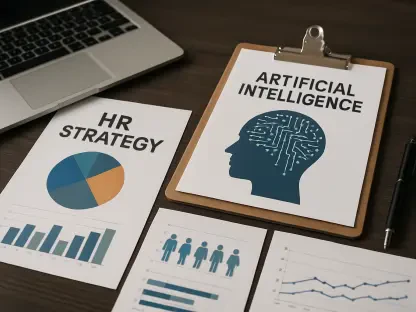In today’s fast-paced business environment, employee engagement is a cornerstone of organizational success and poses significant challenges for many companies. This article delves into the essential role that technology plays in breaking down barriers to engagement, fostering a workforce that is committed and passionate. Understanding and leveraging these technological solutions is crucial for businesses aiming to drive efficiency and growth through a motivated and innovative team.
The Importance of Employee Engagement
Understanding Engagement Dynamics
Employee engagement represents the enthusiasm and dedication employees have toward their roles within an organization. Despite its significance, studies reveal that a mere 31% of employees are genuinely engaged in their work. This low level of engagement is a concern as it directly impacts productivity, innovation, and ultimately, profitability. By creating an engaging and supportive work environment, businesses can unlock the full potential of their workforce, leading to enhanced performance and reduced turnover. Employees feel valued when they see their contributions recognized and appreciated, thus enhancing their overall commitment and productivity.
Engaged employees are defined by their commitment to the organization’s goals, their vigilance against complacency, and their proactive pursuit of excellence. These individuals are more productive and contribute to a positive workplace culture that inspires others. Companies must prioritize engagement strategies to harness this potential, transforming engagement from a mere buzzword to a tangible driver of success. By fostering an inclusive and engaging environment, organizations can significantly boost their competitive edge in an ever-evolving market. Therefore, a comprehensive understanding of engagement dynamics is crucial for business leaders.
Impact on Business Success
The link between employee engagement and business success is well-documented, with engaged employees driving innovative thinking, higher quality outputs, and robust organizational growth. Companies with robust engagement strategies enjoy a 21% higher profitability rate compared to those neglecting this essential aspect. Such numbers highlight the undeniable link between workforce engagement and a company’s bottom line. Engaged employees are not only more productive, but they also advocate for the organization, enhancing its brand reputation and customer satisfaction levels.
Beyond financial metrics, high engagement levels foster a culture of collaboration and continuous improvement. Employees who feel connected to their work bring forward creative solutions and are willing to go the extra mile, providing significant value to the organization. This environment encourages open communication and a collective problem-solving approach, empowering employees to take ownership of their roles. As companies compete in global markets, the ability to retain and motivate highly engaged workers will set successful organizations apart from their peers.
Identifying HR Red Flags
Recognition and Motivation
Recognition is a powerful motivational tool that significantly impacts employee engagement. Alarmingly, 69% of employees have stated they would exert more effort if their hard work were recognized by their employers. This statistic underscores a significant gap in many organizations’ engagement strategies. The absence of recognition can lead to dissatisfaction and disengagement, as employees feel their contributions go unnoticed. Regular acknowledgment of employees’ efforts is crucial in fostering motivation, productivity, and a strong connection to their organization.
Organizations must implement structured recognition programs that celebrate achievements and milestones, both big and small. Recognition can take various forms, from verbal praise to formal awards and incentives. Personalized recognition that acknowledges individual strengths and contributions is particularly effective. Technology plays an integral role in facilitating these initiatives by providing platforms that allow for real-time feedback and peer endorsements. As businesses strive to enhance engagement, a focus on recognition serves as a foundational element for creating a motivated and performance-driven workforce.
The Need for Regular Appraisals
Frequent appraisals are vital to ensuring that employees have the opportunity to engage in meaningful dialogue with their managers. These one-on-one interactions are more than mere evaluations; they are opportunities to align goals, discuss career aspirations, and address any concerns or challenges. However, in many organizations, the hectic pace of work often pushes these appraisals to the back burner, detrimentally impacting employee motivation and progression. Regular and structured appraisals are essential for fostering open communication and advancing employee development.
Combining appraisals with a consistent feedback mechanism allows employees to feel heard and understood, reinforcing their value within the organization. This continuous feedback loop creates a culture of trust and transparency, enabling managers to work closely with their teams to remove obstacles to success. Leveraging technology can streamline the appraisal process by offering tools and platforms that facilitate scheduling, feedback collection, and performance tracking. As companies strive for growth, integrating regular appraisals ensures that employees remain aligned with organizational objectives and personal development goals.
Overcoming Barriers with Technology
Outdated Systems
Outdated technology can significantly hinder HR efforts to enhance employee engagement. Antiquated systems often create inefficiencies and limit HR departments’ ability to engage with employees effectively. These systems, while possibly functional in the past, can now obstruct productivity and limit opportunities for meaningful interaction. It’s crucial for HR teams to embrace modern, integrated systems that allow for seamless management of HR activities, from recruitment to performance evaluation and beyond. Transitioning from legacy systems to modern solutions is pivotal in creating a more dynamic and responsive HR environment.
Incorporating cutting-edge technology into HR processes not only enhances efficiency but also improves data accuracy and communication. Modern HR platforms facilitate streamlined workflows, enabling HR professionals to focus on strategic engagement efforts rather than administrative tasks. These systems often come with robust analytics capabilities, allowing for data-driven insights into workforce dynamics. By upgrading outdated technology, organizations can ensure HR departments operate as effective partners in fostering an engaged and motivated workforce, providing scalable solutions adaptable to the evolving needs of the organization.
Personalizing HR Practices
The traditional ‘one-size-fits-all’ approach in HR practices is increasingly becoming obsolete as workplaces become more diverse and individually oriented. Personalization, made possible by advanced technology, is essential for crafting HR experiences that reflect the unique needs and aspirations of each employee. Technology enables HR departments to analyze data effectively, tailoring interactions and support systems to meet distinct employee preferences and challenges. Implementing personalized HR practices can significantly enhance employee satisfaction and retention rates.
Personalized HR approaches are achieved through tools that gather comprehensive data on employee preferences, career goals, and performance metrics. This data empowers HR professionals to create a more individualized employee experience, from tailored learning paths and development programs to personalized health and wellness initiatives. Additionally, personalized communication fosters stronger relationships between employees and management, driving engagement and loyalty. By leveraging technological advancements, organizations can create a customized employee experience that promotes a sense of belonging and alignment with company goals.
Strategies for Enhanced Engagement
Facilitating Seamless Communication
In an age where digital connectivity is paramount, businesses must cultivate open channels of communication to maintain strong employee relations. Virtual communication platforms can significantly improve team dynamics by facilitating regular updates, meetings, and brainstorming sessions. These platforms allow employees to stay informed and engaged, creating an inclusive environment that fosters collaboration and innovation. Technology-driven communication tools are invaluable for businesses aiming to transcend geographical barriers and cultivate a cohesive organizational culture.
Ensuring open dialogue through digital platforms not only keeps employees aligned with company goals but also empowers them to contribute actively to decision-making processes. This sense of inclusion promotes a collaborative atmosphere where team members can share insights and drive collective growth. Organizations can leverage a variety of communication tools to maintain transparency and enhance interpersonal relationships within the workforce. By harnessing these technologies, businesses create an agile environment that supports continuous engagement and adaptive communication strategies that resonate with a contemporary workforce.
Prioritizing Wellbeing and Mental Health
In today’s rapidly evolving business world, employee engagement remains a vital element for achieving organizational success, yet it presents considerable challenges for many corporations. This article explores the crucial part technology plays in dismantling obstacles to engagement, nurturing a workforce that is not only committed but also passionate. Harnessing and utilizing these technological solutions is indispensable for companies seeking to boost efficiency and growth through a motivated and innovative team. In this competitive era, technology offers tools like collaboration software, feedback platforms, and performance tracking systems to enhance communication and connect employees with organizational goals. By integrating these digital solutions, companies can foster an inclusive and dynamic work environment, ultimately driving success. As businesses aim for progress and prosperity, leveraging technology to enhance employee engagement becomes essential in creating a harmonious and productive culture that aligns with broader corporate objectives.









